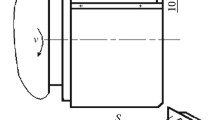Abstract
Wear and fracture resistance of several kinds of alumina series ceramic tool materials in continuous and intermittent machining of carbon steels are investigated. Morphologies of various wear and fracture cracks formed on the surface of tool insets after cutting operation are analyzed in detail. Mechanisms of cracks formation and their effects on wear and fracture resistance of ceramic tool materials are analyzed with SEM and TEM observation. The formed cracks in continuous machining can result in the acceleration of tool wear. In intermittent machining, the formation and propagation of cracks is also responsible for early fracture of cutting tools. The mechanical fatigue cracks and thermal cracks resulted from the combined action of both mechanical and thermal stresses are the dominant reasons for the late fracture of ceramic cutting tools.
Similar content being viewed by others
References
Adams JH (1991) Ceramic cutting tools. Engineering materials handbook: ceramics and glasses, vol 4. Materials Information Society, Metals Park, Ohio, pp 966–978
Ai X, Li ZQ (1994) Characteristics of ceramic tool facture. Key Eng Maters 96:165–196
Casto SL, Valvo EL (1993) Wear mechanism of ceramic tools. Wear 160:227–232
Gwidon W, Stachowia K (1994) Wear behavior of ceramic cutting tools. Key Eng Maters 96:137–145
Brandt G (1999) Ceramic cutting tools: state of art and development. Maters Tech 14:17–26
Barry J, Byrne G (2001) Cutting tool wear in the machining of hardened steels - Part I: alumina /TiC cutting tool wear. Wear 247:139–146
Novak S, Kalin M, Kosmac T (2001) Chemical aspects of wear of alumina ceramics. Wear 250:318–325
Ai X, Xia CB (1989) Study on the fracture criterion of ceramic tools when machining steels intermittently. J Chin Mech Eng Soc 3:1–5
Xu CH, Ai X (2001) Particle dispersed ceramic composite reinforced with rare earth additions. Int J Refract Metals Hard Maters 19:85–88
Xu CH, Ai X, Huang CZ, Deng JX (2000) Strengthening and toughening effect of yttrium on Al2O3/TiCN ceramic tool material. J Rare Earths 18:73–76
Xu CH, Ai X (2004) Multiphase tailoring and design of an advanced ceramic material. Key Eng Maters 259–260:112–115
Xu CH, Huang CZ, Li ZQ, Ai X (2000) Al2O3/SiC/(W,Ti)C multiphase composite ceramic material. J Chin Ceram Soc 28:538–543
Evans AG, Marshall DB (1990) Fundamentals of friction and wear of materials. ASM, Metal Park, OH
Deng JX (2001) Friction and wear behaviour of Al2O3/TiB2/SiCw ceramic composites at temperatures up to 800°C. Ceram Int 27:135–141
Huang CZ (1994) Development of new ceramic tool materials and their cutting reliability. Dissertation, Jinan, Shandong University of Technology (in Chinese)
Author information
Authors and Affiliations
Corresponding author
Rights and permissions
About this article
Cite this article
Xu, C., Huang, C. & Ai, X. Cutting behavior and related cracks in wear and fracture of ceramic tool materials. Int J Adv Manuf Technol 32, 1083–1089 (2007). https://doi.org/10.1007/s00170-006-0431-8
Received:
Accepted:
Published:
Issue Date:
DOI: https://doi.org/10.1007/s00170-006-0431-8



